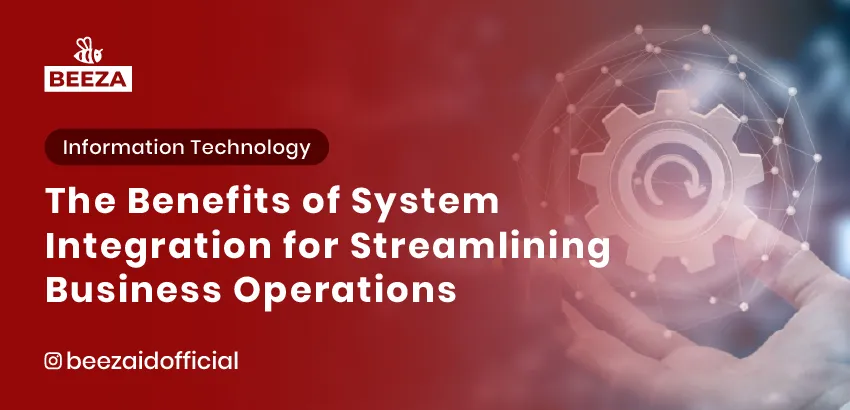
Introduction: Benefits of System Integration
In today’s digital age, businesses are increasingly looking for ways to improve their operations and stay competitive in a fast-evolving market. One of the most effective solutions to achieve this is system integration. System integration refers to the process of connecting different software applications, systems, or departments to work together seamlessly. This integration helps businesses streamline their operations, enhance productivity, and reduce errors that could arise from manual data management.
This article will explore the key benefits of system integration in business operations and how it can contribute to improving efficiency, reducing operational costs, and providing better decision-making capabilities.
What is System Integration?
System integration involves linking multiple software applications or platforms within an organization to communicate and share data automatically. This process eliminates the need for manual data input or separate processing in various departments or divisions. By ensuring that systems work together smoothly, businesses can optimize workflows, enhance data accuracy, and reduce the time spent on repetitive administrative tasks.
A simple example of system integration is connecting a Customer Relationship Management (CRM) system with an accounting system. This way, customer transactions or information from the CRM are automatically updated in the accounting system, without the need for manual data entry.
Benefits of System Integration in Business Operations
1. Increased Operational Efficiency
One of the primary benefits of system integration is the enhancement of operational efficiency. By linking different systems, businesses can streamline workflows and reduce the time it takes to move data from one system to another. Employees can focus on more strategic tasks rather than spending time on manual data input or reconciling data across different systems.
💡 Example: By integrating inventory management with order processing systems, businesses can track stock levels in real-time, ensuring that orders are fulfilled quickly and accurately.
2. Reduced Data Errors
Manual data entry and siloed systems increase the risk of human error. With system integration, data is automatically synchronized across systems, minimizing the chances of incorrect or outdated information being used. This ensures that the business operates with up-to-date, accurate data across all departments.
💡 Example: In an integrated finance system, every sale recorded in the sales department is immediately reflected in the accounting system, reducing the risk of discrepancies in financial reporting.
3. Faster and More Accurate Decision-Making
System integration allows for real-time access to consolidated data from multiple departments. This provides decision-makers with a more complete and accurate view of the business, enabling faster and better-informed decisions. When all data is available in one place, businesses can respond more quickly to market changes and operational needs.
💡 Example: Integrating sales, production, and financial data allows management to assess overall company performance, forecast trends, and make strategic decisions based on real-time insights.
4. Improved Customer Experience
System integration enhances the customer experience by providing more accurate and timely information. When systems such as customer service, order processing, and inventory management are integrated, businesses can offer a seamless service experience. Customers will benefit from real-time updates on their orders, product availability, and delivery status, increasing their satisfaction and loyalty.
💡 Example: An integrated e-commerce platform allows customers to track their order status and receive updates about delivery times, improving transparency and customer trust.
5. Cost Savings
By integrating systems, businesses can eliminate redundant processes, reduce the need for manual data entry, and cut down on operational inefficiencies. This leads to cost savings in both the short and long term. Furthermore, businesses can reduce the need for maintaining separate systems and software, leading to lower IT costs and reduced training requirements.
💡 Example: A company using a single integrated platform for finance, sales, and inventory management can reduce the need for multiple software licenses, lowering operational costs.
How to Implement System Integration?
1. Choose the Right Integration Platform
The first step in implementing system integration is selecting the appropriate integration platform or solution. Many software vendors provide integration platforms that can connect different systems within a business. It is crucial to choose a platform that suits the specific needs of your business and can scale as the company grows.
2. Ensure Data Security and Compliance
With system integration, businesses must ensure that the data being shared across platforms is secure. Implementing strong data security measures such as encryption and secure authentication is vital. Additionally, businesses must ensure that the integrated systems comply with relevant data protection regulations, such as GDPR, HIPAA, or other industry standards.
3. Employee Training and Adaptation
Successful implementation of system integration requires proper training for employees to ensure they understand how to use the new systems effectively. Clear communication and training programs will help employees adapt quickly and minimize any disruptions to business operations during the transition.
Conclusion
System integration offers numerous benefits for businesses, including enhanced operational efficiency, reduced errors, and the ability to make faster, more informed decisions. By streamlining processes and improving data accuracy, businesses can create a more responsive and productive work environment. Additionally, system integration helps enhance customer experiences and provides cost-saving opportunities, making it a valuable tool for companies aiming to remain competitive in the digital age.
💡 Want to streamline your business operations with integrated systems? Contact Beeza to learn how our digital solutions can help integrate your business systems for improved efficiency and growth! 🚀